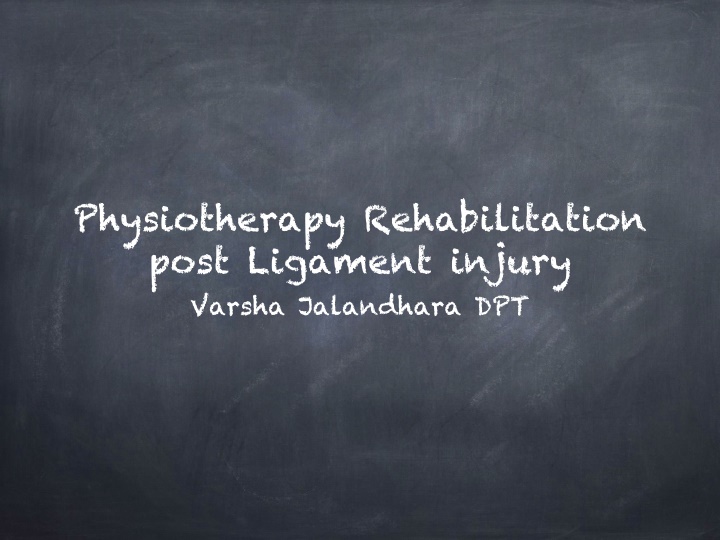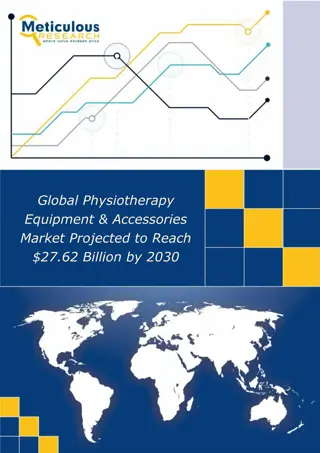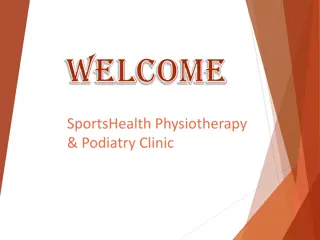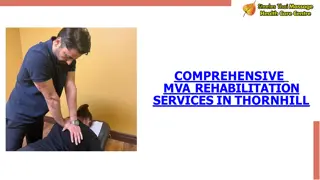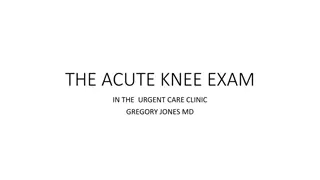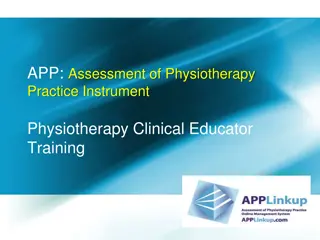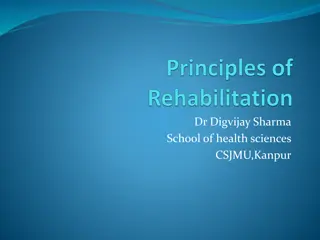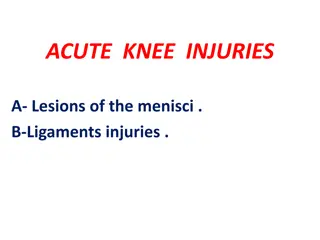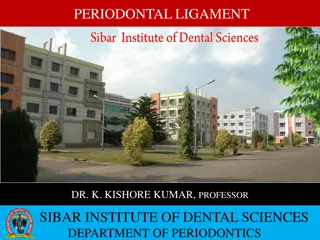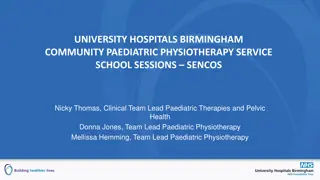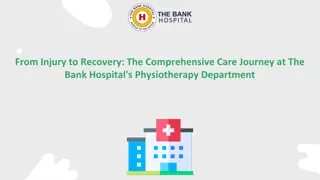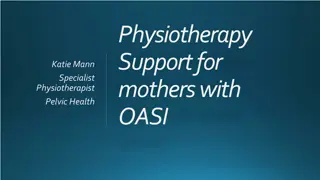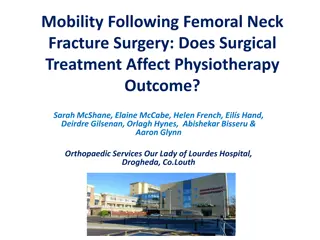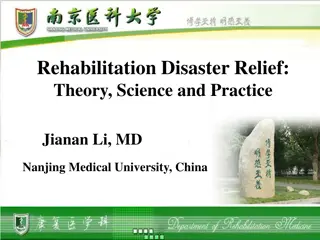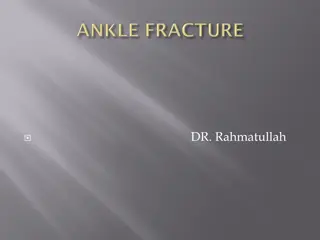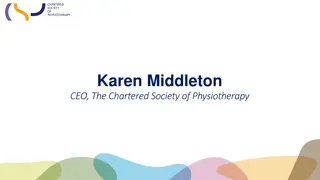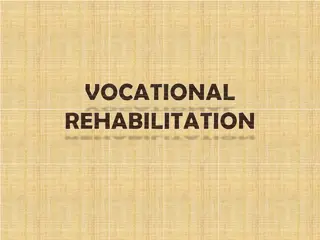Physiotherapy Rehabilitation for Post Ligament Injury - Varsha Jalandhara, DPT
In the acute stage of post-ligament injury, physiotherapy focuses on reducing inflammation and pain through techniques like cryotherapy and protective measures. As the injury progresses to the sub-acute stage, mobilization and strengthening exercises are gradually introduced to improve range of motion and muscle strength. Isometric exercises and passive stretching play a crucial role in promoting recovery and preventing complications. Throughout the rehabilitation process, a structured approach is followed to aid the patient in regaining function and mobility.
Download Presentation

Please find below an Image/Link to download the presentation.
The content on the website is provided AS IS for your information and personal use only. It may not be sold, licensed, or shared on other websites without obtaining consent from the author.If you encounter any issues during the download, it is possible that the publisher has removed the file from their server.
You are allowed to download the files provided on this website for personal or commercial use, subject to the condition that they are used lawfully. All files are the property of their respective owners.
The content on the website is provided AS IS for your information and personal use only. It may not be sold, licensed, or shared on other websites without obtaining consent from the author.
E N D
Presentation Transcript
Physiotherapy Rehabilitation post Ligament injury Varsha Jalandhara DPT
Acute Stage of injury The main aim of physiotherapy in the acute stage is reduction of inflammation and pain. 1. Cryotherapy Ice packs for 15 min every hour. 2. Modalities like diapulse, ultrasound therapy, interferential therapy and TENS can be used. 3. Compressive or pressure bandage with limb in elevation. 4. Protection of knee from the position of stress.
5. Early initiation of isometrics for the quadriceps. They should be done at least for 5 min every hour. Prevention of quadriceps wasting and reflex inhibition is important. The isometrics, progressed slowly to the maximum and sustained for 10 15 s, assist in strengthening the quadriceps; whereas speedy isometrics help in resolution of oedema and effusion. 6. When the leg is immobilized in a POP cast, vigorous movements to the ankle and toes are important to prevent venous thrombosis and to augment circulation. Static contractions to hamstrings and quadriceps in the cast are encouraged. Attempt may be made to perform assisted SLR, abduction of the hip and strong hip extension against the resistance of the mattress. 7. If cast is not advised, a small range of self-assisted relaxed gentle knee swinging could be initiated.
Sub acute injury When the symptoms of the acute stage are reduced, mobilization is initiated and progressed gradually along with strengthening exercises. 1. Initiate mobilization with the patient sitting at the edge of the bed or table, injured limb fully supported by the sound limb. The patient is guided to perform relaxed self- assisted small range of slow rhythmic knee flexion and extension. CPM is an ideal mode of mobilization at this stage.
2. The range of quadriceps and hamstrings should be recorded. 3. Passive exercise to be progressed to assisted active or active as early as possible. Self-assisted relaxed passive stretching of knee flexion is excellent for improving the ROM of flexion. Patient in supine or sitting position slides the foot as far back as possible. Then the patient plants the foot on the plinth and slowly moves forward over the planted foot; the maximally achieved flexion is maintained. This can be more effective if it succeeds the relaxed free heel-drag session.
4. Isometrics can be made self-resistive by the patient applying graded resistance with hand. A soft roll is placed under the knee. The patient carries out isometric quadriceps setting while resistance is applied by hand, exerting pressure by the web between the thumb and the index finger 5 7 cm proximal to the superior border of the patella. With isometric contraction, the patella moves upwards. The patient resists this movement with hand and then sustains the isometric hold by continuously resisting upward pressure exerted by quadriceps with the hand for 10 15 s. This can be made more effective by adding ankle dorsiflexion with toes stretched in extension. We have found this to be a very effective self-controlled isolated quadriceps exercise. It is also well acceptable to the patient.
5. SLR- Progressed to SLR + SLA ( Side lying hip abduction). 6. Knee flexion: Knee flexion exercises should be practiced in prone position as well as on a static bicycle. Speed, resistance and seat height of the static bicycle should be properly adjusted so as not to overstrain the knee. Begin with half circle of the pedal. The session should be for 15 min initially, increasing gradually to an hour. 7. 5. Relaxed knee swinging should be made speedy with increased arc of movement to attain free mobility.
8. Progressive resistive exercise (PRE): Gradual self-resistive exercise with self-generated tension or graded resistance exercise with De lorme shoe or weight belts to be initiated. 9. Flexibility exercises: Flexibility exercises of static stretching using a 30-s hold, relaxing and performing five repetitions to hamstrings, iliotibial band and gastrosoleus are important. 10. Vigorous programme: When the pain is minimal, ROM and swelling are near normal. The endurance strengthening flexibility exercises are made progressive by suitable techniques. Progress to guided prone-kneeling, assisted squatting, stair climbing and descending and cross-leg sitting.
A. Graduated spot running and jogging to be initiated as soon as the pain permits. B. Patients should be encouraged to begin aerobics and go back to work with well learnt precautionary measures. Advice on regular sessions of continuous halfway floor squatting to be emphasized to keep fit and to prevent recurrence of sprain
Chronic stage of Injury Even chronic ligament injuries respond favourably to the regime of knee strengthening and hamstrings stretching exercises. However, the knee should be well protected with a knee brace during strenuous activities. Patients with chronic ligament instability may show weakness of hip muscles and hamstrings. This has to be tested and strengthening exercises to these muscle groups are included in the therapy whenever necessary.
Surgical repair Tears of the menisci: Torn meniscus is better excised. The operation of meniscectomy can be performed by an arthrotomy of the knee or by arthroscopic surgery. Open meniscectomy: It is performed by doing an arthrotomy of the knee joint. A compression bandage is given to the knee joint, after operation. The bandage is removed after 2 weeks and the knee is mobilized. Weight bearing, however, is started after 3 4 weeks, after building up tone in the quadriceps muscle.
Post operative management of meniscectomy 1st day Ankle circumduction. 2nd day (a) Simultaneous quadriceps and hamstrings isometrics are very important and should be endured. (b) Walking, gradual weight bearing with crutches. 5th day (a) Assisted SLR could be begun if not too painful. (b) Hamstrings stretching sessions should be started. 2nd week (a) Active and active assisted flexion extension exercises. (b) Resistive hamstrings exercise to inhibit quadriceps thereby allowing more flexion. (c) Passive patellar mobilization. Progress to resisted techniques. Cycling and Running by 1 month.
Post operative manegement after ligament repair There is usually a prolonged period of immobilization (about 6 weeks), hence: (a) Ankle movements, quadriceps and hamstrings isometrics should be started in the cast. (b) Non weight-bearing crutch walking should be initiated immediately. (c) Assisted SLR may be begun after a week. (d) Knee hinge cast (functional cast bracing) may be applied after 10 days to allow small range of knee flexion extension. (e) By 6 to 8 weeks, the cast is removed. Knee flexion extension exercises are made vigorous.
Since the process of ligament reorganization is very slow, these patients should be put on vigorous activities only after a year. They may require 4 6 months to regain full extension. Utmost care is needed while teaching floor squatting and cross-leg sitting.
Arthroscopy and Arthroscopic surgery Arthroscope is a tubular endoscope through which the inside of a joint can be visualized. It is most commonly performed on the knee joint. However, other joints like shoulder, elbow, wrist and ankle can also be visualized with an arthroscope. Indications for arthroscopy 1. Recurrence of symptoms 2. Locked knee joint 3. In the diagnosis of internal derangements of the knee joint and loose bodies, etc.
Arthroscopy is very useful in the diagnosis and assessment of various knee disorders and internal derangements like tears of menisci and cruciate ligaments. Apart from diagnosis, the arthroscope is used for therapeutic purposes also. Nowadays, the various structures in a joint can be operated upon without performing a formal arthrotomy by inserting athroscopic fine instruments through a second puncture in the joint. This arthroscopic surgery helps in removal of torn or degenerated menisci and loose bodies from the knee joint and even helps in the reconstruction of torn cruciate ligaments.
Arthroscopic surgery (diagnostic as well as therapeutic) is performed through one or two small puncture wounds in the skin. Postoperatively, generally, a compression bandage is given for about a week. The period of hospitalization is only a day or two. Therefore, the greatest advantage of arthroscopy is rapid rehabilitation. Mobilization and non weight-bearing can be started within a week, and full weight bearing in the second week.
Physiotherapy management after arthroscopic surgery. The physiotherapeutic management depends upon the type of lesion and the arthroscopic procedure procedure which could be diagnostic or therapeutic. In a diagnostic arthroscopy, the programme of physiotherapy is short and simple. It is basically directed to maintain and improve the knee function. The basic principles of physical therapy are as follows: 1. Reduction of effusion 2. Quadriceps isometric contractions 3. Maintenance of full ROM 4. Relaxed knee swinging 5. Proper weight bearing and walking
Physiotherapy for arthroscopic surgery: As for any other surgical procedures, the management falls into the following two distinct phases. Preoperative training This has a conditioning effect on the patients and shortens the period of recovery. It consists of: 1. Teaching the exact technique of isolated, sustained isometric submaximal contractions of the quadriceps to avoid atrophy and reflex inhibition. 2. Relaxed speedy quadriceps settings to reduce effusion and oedema. 3. SLR to stabilize the knee. 4. Resistive exercise for hamstrings and gastrosoleus to increase the posterior stability of the knee. 5. Relaxed coordinated knee swinging for the early return of knee flexion ROM. 6. Single leg standing, balancing, weight transfers and gait training.
Post operative regime Phase I: Immediate postoperative period (3 5 days) days). Phase II: Phase of early healing (5 15 days). Phase III: Phase of late healing (15 21 days). Phase IV: Phase of conditioning (3 5 weeks). Phase V: Functional progression (6 weeks onwards).
Phase 1 (immediate post operative period) To reduce pain: Electrotherapeutic modality + Relaxation training 2. To reduce effusion Speedy quadriceps settings or electrical stimulation under pressure bandage with the limb in elevation; resistive ankle, foot movements and SLR 3. To prevent reflex inhibition Sustained frequent isolated quadriceps setting with hold for 6 10 s 4. Supported relaxed knee passive swinging in small range with normal contralateral leg
Phase 2: Early healing (515 days) Gradual but definite progression of earlier measures in Phase I + Add: 1. Knee rachet, pedocycle or static exercise regime 2. Weight transfers 3. Supported or full weight-bearing ambulation 4. Knee ROM should be 90 degrees at least .
Phase 3(15-21 days) 1. Vigorous progressive resistive quadriceps exercise, supported and guided functional positions 2. Floor squatting, cross leg-sitting and prone heel sitting (kneeling) 3. Standing on the affected leg alone, ambulation unsupported or with minimal support, but no limp 4. Knee ROM should be around 120 degrees
Phase IV 1. High sitting speedy isotonic full ROM, relaxed knee swinging 2. Progressive resistive quadriceps exercises 3. Balance activities proprioception 4. Gait training 5. Return to work
Phase V (Functional progression) 1. Spot running by holding wall bars 2. Straight jogging 3. Straight running 4. Jumping, hopping 5. Agility drills (e.g., figure-of-eight running) 6. Gradual return to sports
Type a quote here. Johnny Appleseed
